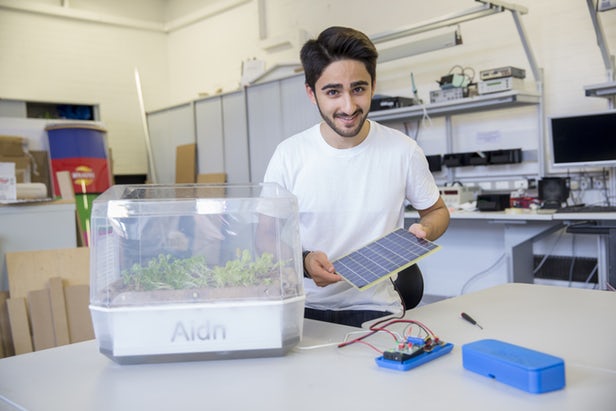No dirt no problem: Low-cost kit grows plants in mid-air

Nikian Aghababaie says his low-cost kit will allow families in harsh climates to cultivate vegetables using 90 percent less water
Technologies developed to grow without soil and nutrients might not only help with future space missions, but could also prove pivotal in feeding the developing world. For design student Nikian Aghababaie, this is exactly where he drew inspiration from for a low-cost approach to growing vegetables without soil and using minimal water, something he hopes can ease world hunger and generate income for rural communities.
There are a variety of research projects underway that seek to develop new methods of growing food in space, such as the Potatoes on Mars Project and the University of Southampton's #LettuceOnMars experiments. But it was the goods produced on the International Space Station (ISS) that provided Aghababaie, a fourth year student at Nottingham Trent University, with the basis for his new technology.
Technologies developed to grow without soil and nutrients might not only help with future space missions, but could also prove pivotal in feeding the developing world. For design student Nikian Aghababaie, this is exactly where he drew inspiration from for a low-cost approach to growing vegetables without soil and using minimal water, something he hopes can ease world hunger and generate income for rural communities.
There are a variety of research projects underway that seek to develop new methods of growing food in space, such as the Potatoes on Mars Project and the University of Southampton's #LettuceOnMars experiments. But it was the goods produced on the International Space Station (ISS) that provided Aghababaie, a fourth year student at Nottingham Trent University, with the basis for his new technology.
Astronauts aboard the ISS are able to grow food many miles away from the nearest patch of soil with an elaborate, and expensive, plastic greenhouse. Here seeds are embedded in rooting pillows which replace the soil, promoting root growth and holding water. In August 2015 the astronauts ate their first space-grown lettuce leaves.
Aghababaie adapted this technology by reading up on 30 years of NASA research papers and interviewing industry professionals. His much more affordable version works by suspending seedlings in mid-air inside a growing chamber. It relies mostly on easily accessible materials, with the nutrient solution sprayed onto the roots via pierced plastic bottles and the oxygen able to circulate around the exposed roots to promote growth.
In addition to the cheap materials and no soil, Aghababaie says his kit will allow families in harsh climates to cultivate vegetables using 90 percent less water than conventional methods. He has teamed up with a Peruvian charity called EcoSwell to see how the local community of Lobitos can use a prototype to grow their own food.
"One of the advantages of using the growth kit is that it will enable communities to grow a variety vegetables quickly and easily," he says. "Communities can research gaps in the market to see if they can grow produce that is unique to the area, which they can then sell at higher prices and potentially make a profit from."
From there, he hopes to one day scale up the technology so it can be used for larger productions, and is set to present the growing kit at the New Designers exhibition in London next summer.
"Nikian has shown how complex technology can be simplified and adapted into an appropriate and affordable product that can help people in developing countries alleviate hunger and malnutrition," said Dr Matthew Watkins, course leader for product design at Nottingham Trent University. "Nikian has worked very hard to make sure his product is accessible and easy to use, going above and beyond requirements to test the product in its intended environment."
Source: Nottingham Trent University

